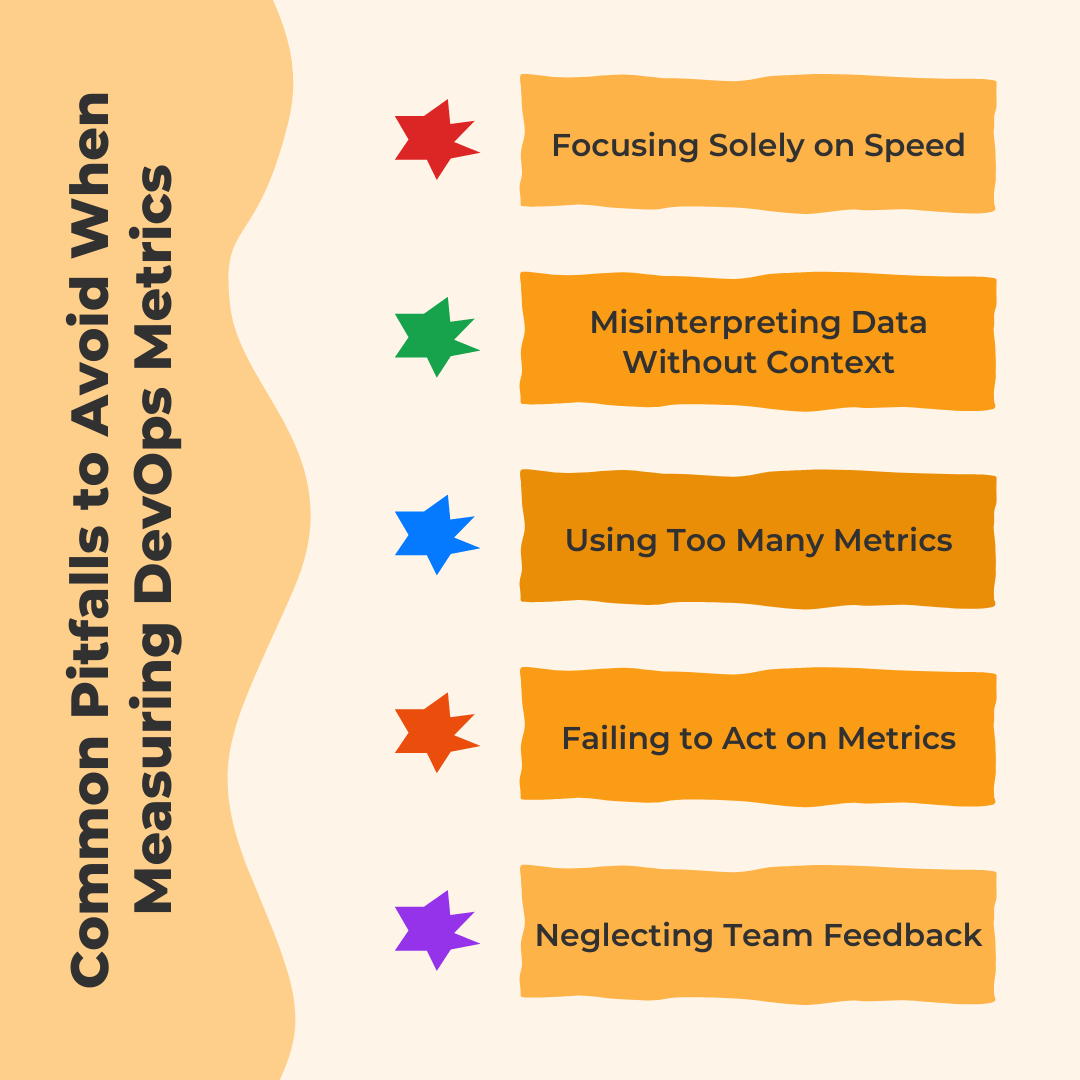Introduction
In today’s fast-paced tech world, DevOps performance often falls short due to unclear metrics. Without precise measurements, teams struggle to identify inefficiencies and bottlenecks, leading to slower deployments and frequent disruptions.
The solution? Implementing the right metrics. By focusing on key performance indicators like Lead Time for Changes and Deployment Frequency, organizations can optimize their processes, enhance agility, and achieve smoother, more reliable software delivery.
Key Metrics to Measure DevOps Performance
To ensure the success of DevOps practices, it’s crucial to track metrics that reveal the team’s performance and efficiency. Below are five essential metrics:
Lead Time for Changes
Lead time measures how quickly code moves from commit to production. Faster lead times mean quicker responses to customer needs, driving innovation. Teams can improve this by automating their CI/CD pipelines.
Deployment Frequency
Deployment frequency indicates the rate at which updates are released to production. Higher frequencies indicate that teams can release updates quickly and consistently, shortening time-to-market and helping businesses stay competitive.
Change Failure Rate
This metric tracks the percentage of deployments that result in failures within the production environment. Lower failure rates indicate better code quality and more effective testing. Continuous testing and rigorous validation processes help reduce this rate, leading to more stable releases.
Mean Time to Recovery (MTTR)
MTTR (Mean Time to Recovery) tracks the time it takes to restore functionality after a failure. Faster recovery times minimize the impact of outages and enhance system reliability. Teams can reduce MTTR by implementing automated rollback procedures and effective incident management strategies.
Cycle Time
Cycle time measures the entire duration from development to deployment. Shorter cycle times reflect streamlined workflows and faster delivery of features. Improving cycle time requires the continuous integration of feedback loops and more efficient processes.
Advanced Metrics for Comprehensive DevOps Insights
Beyond the basic metrics, advanced metrics offer deeper insights into the efficiency and health of a DevOps environment.
Throughput and Velocity
These metrics measure the speed at which the team delivers code and how many features or fixes are deployed within a specific period. Higher throughput reflects a faster, more efficient pipeline.
Customer Experience Metrics
Uptime, latency, and overall service availability are crucial to understand the user experience. These metrics help monitor service health and identify issues before they impact users.
Quality Assurance Metrics
Metrics such as the number of bugs found in production or the success rate of automated tests provide insights into the code's quality. By focusing on these, teams can ensure that they maintain high-quality releases.
Tools to Measure DevOps Metrics
To measure DevOps performance effectively, the right tools are essential for tracking key metrics. Below are some of the most frequently used tools:
Jenkins
Jenkins automates continuous integration (CI) and continuous delivery (CD) pipelines, tracking metrics like deployment frequency and lead time.
Prometheus
Prometheus is highly effective for monitoring system health, providing real-time alerts for metrics such as uptime and latency.
Datadog
Datadog provides a comprehensive view of application performance, tracking everything from infrastructure metrics to user experience.
How to Set Benchmarks for DevOps Metrics
Setting benchmarks for DevOps metrics is crucial to understanding performance relative to industry standards and internal goals.
Why Benchmarking Matters
Benchmarks provide context for your metrics, helping teams assess whether they are on track with industry leaders or need improvement.
Setting Realistic Benchmarks
Begin by assessing your current performance based on key metrics. Compare them against industry averages or competitors to set achievable goals. Be sure to account for your company’s size, development cycle, and team capabilities.
Continuous Adjustment
DevOps is an evolving practice, so benchmarks should be regularly reviewed and adjusted to align with changing business goals or technological advancements.
How to Improve DevOps Metrics
Improving DevOps metrics requires a continuous focus on refining processes and adopting automation.
Continuous Improvement Strategies
Regularly review and optimize workflows to enhance metrics like lead time and deployment frequency. Automation plays a key role in reducing manual errors and speeding up processes.
Collaboration and Feedback Loops
Strengthen communication between development and operations teams to resolve issues faster. Implement feedback loops to address challenges as they arise, improving metrics like change failure rate and MTTR.
Common Pitfalls to Avoid When Measuring DevOps Metrics
Measuring DevOps performance is critical, but common mistakes can distort the data and mislead improvements.
Focusing Solely on Speed
Many teams emphasize speed-related metrics, such as deployment frequency, while neglecting quality. Prioritize metrics like change failure rate and recovery time to balance speed with stability.
Misinterpreting Data Without Context
Metrics need context for proper analysis. For example, high deployment frequency without checking the quality of changes can lead to more frequent failures.
Using Too Many Metrics
Monitoring too many metrics can overwhelm teams and shift focus. Focus on the most relevant KPIs to maintain clarity and effectiveness.
Failing to Act on Metrics
Collecting data without using it to drive improvements leads to wasted effort. Ensure actionable insights follow metric tracking.
Neglecting Team Feedback
Relying solely on tools can miss critical human insights. Involve teams in interpreting metrics and identifying improvement areas.

Key Takeaways
- Lead Time for Changes: Tracks the duration from code commit to deployment in production. Shorter lead times boost business agility, which can be achieved through automation and continuous integration.
- Deployment Frequency: Monitors the rate at which code changes are deployed. A higher frequency suggests greater stability and faster delivery.
- Change Failure Rate: Percentage of changes that cause production failures. Lower rates reduce disruptions. Enhance by adopting stronger testing protocols and automation.
- Mean Time to Recovery (MTTR): Time needed to recover from production failures. Faster recovery minimizes downtime. Best practices include effective incident management and automated rollback.
- Cycle Time: Total time from development to deployment. Shorter cycle times reflect greater efficiency. Achieve this by implementing feedback loops and improving CI/CD pipelines.
Conclusion
Balancing speed, stability, and quality is key to DevOps success. By focusing on essential metrics like Lead Time for Changes, Deployment Frequency, Change Failure Rate, Mean Time to Recovery (MTTR), and Cycle Time, organizations can enhance efficiency and agility. These metrics provide insights into delivery speed, system stability, and overall operational effectiveness.
Adopting a data-driven approach and setting realistic benchmarks are crucial for continuous improvement. Avoid common pitfalls such as prioritizing speed over quality, and instead, leverage advanced metrics and the right tools to drive innovation and maintain a competitive edge. This approach ensures timely, high-quality software delivery and long-term success.

